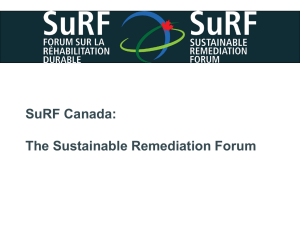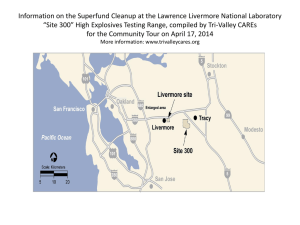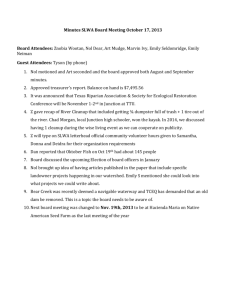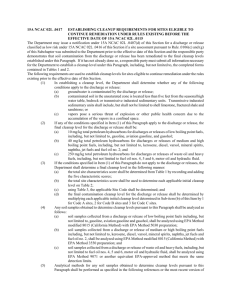ABCA_Caird_Engineering_Works_rev_a
advertisement
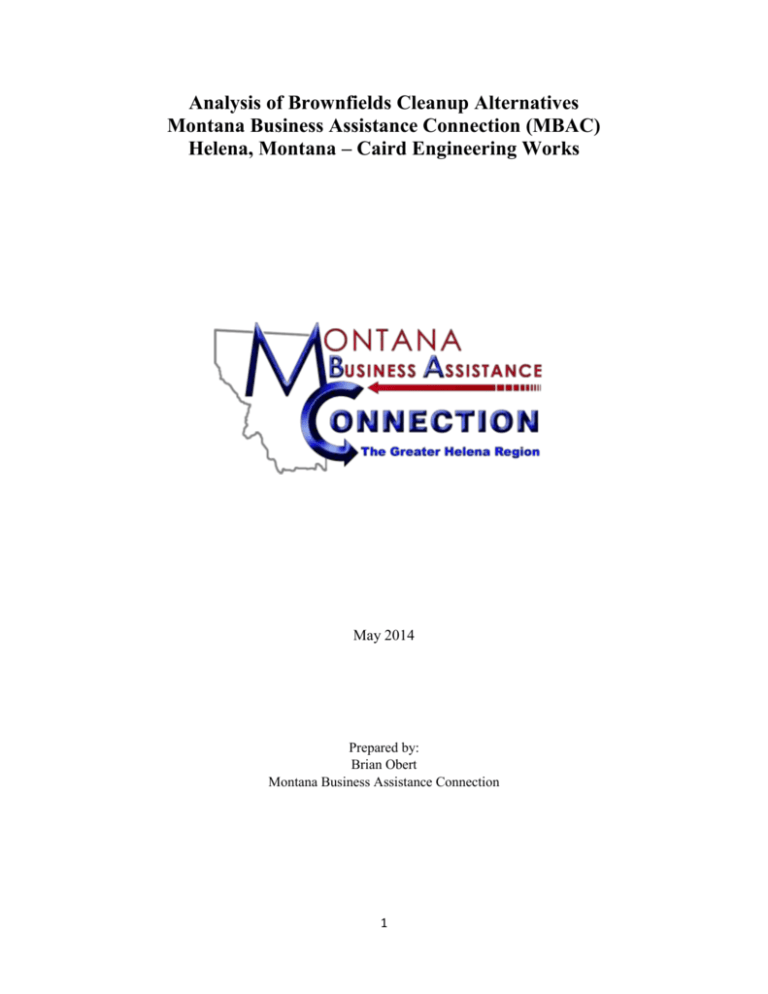
Analysis of Brownfields Cleanup Alternatives Montana Business Assistance Connection (MBAC) Helena, Montana – Caird Engineering Works May 2014 Prepared by: Brian Obert Montana Business Assistance Connection 1 Table of Contents Introduction ................................................................................................................................................. 3 Scope ............................................................................................................................................................ 3 Background ................................................................................................................................................. 3 Site Location ............................................................................................................................................. 3 Previous Site Uses and Previous Cleanup Activity................................................................................... 3 Site Assessment Findings ......................................................................................................................... 4 Project Goal .............................................................................................................................................. 5 Applicable Regulations ............................................................................................................................... 5 Cleanup Oversight Responsibility ............................................................................................................ 5 Cleanup Regulations ................................................................................................................................. 5 Evaluation of Cleanup Alternatives .......................................................................................................... 6 Cleanup Objective ..................................................................................................................................... 6 Cleanup Alternatives Considered.............................................................................................................. 6 Evaluation of Alternatives ........................................................................................................................ 6 Description ................................................................................................................................................ 6 Effectiveness ............................................................................................................................................. 7 Implementability ....................................................................................................................................... 8 Costs.......................................................................................................................................................... 8 Decision Matrix ........................................................................................................................................ 9 Evaluation of Cleanup Alternatives .......................................................................................................... 9 2 Introduction This document presents an Analysis of Brownfields Cleanup Alternatives (ABCA) for the Caird Engineering Works, 1311 N. Montana Avenue, Helena Montana. This document was prepared by Montana Business Assistance Connection (MBAC) as part of the EPA Brownfield Cleanup Grant Application. Notice of this document has been published and made available for comment, in accordance with the community relations plan of the EPA Brownfields Grant. Scope The scope of work for this ABCA is to identify, evaluate and select an appropriate cleanup plan to address the contamination at the former Caird Engineering Works property. The ABCA uses information provided in the Phase I Environmental Site Assessment (ESA)1, Phase II ESA2, a preliminary Cleanup Plan3 and a final Cleanup Plan4 for the property. Background Site Location The Site consists of thirty-one tracts of land – Northern Pacific Addition, Block 5, lots 1-14 and 17-33 with five Geo codes, 05-1888-29-2-13-01, 05-1888-29-2-13-10, 05-1888-29-2-1318, 05-1888-29-2-18-01, and 05-1888-29-2-18-09. The property corresponds to both addresses 1311 North Montana Avenue, and 1200 Boulder Avenue. Previous Site Uses and Previous Cleanup Activity The Caird Engineering Works, 1311 N. Montana Avenue, operated at this location since 1895. The foundry and machine shops focused initially on the fabrication of mining equipment including balls and liners for crushing mills, ore cars, shaft cars and dredge pieces. In 1896, they began accepting orders from the American Smelting and Refining Company’s (ASARCO) sites in Helena and Great Falls. After 1910, Caird Engineering began to receive large contracts from communities for street lamp posts and trolley poles, manhole liners and covers, and storm drains. During World War II, Caird also completed several large contracts for the U.S. Army and Navy. By the early 1950s, Caird Engineering began to manufacture steel overpass beams for the Montana Highway Department. A row of buildings occupy the west boundary of the Site and include, from north to south: a Foundry, Lower Machine Shop, Office, Upper Machine Shop, and Welding Shop. A small concrete 1 Phase I ESA 2009, Phase I ESA update 2011 (Tetra Tech) Phase II ESA 2009, Phase II ESA Addendum 2012 (Tetra Tech) 3 Preliminary Cleanup Plan 2010 (Tetra Tech) 4 Final Cleanup Plan 2013 (Tetra Tech) 2 3 block building is located along the north boundary of the Site. Three open sheds are located along the south boundary. The buildings were constructed between about 1921 and 1957. Until the 1980s, the Great Northern/Burlington Northern railroad ran through the site. Foundry operations at Caird involved first making a wood pattern that was an exact replica of the final product. Patterns were made in a shop in the southeast portion of the Site. The wood pattern was then used in conjunction with molding sand in frames to produce a hollow mold. This activity occurred in the foundry at the northwest corner of the Site where molten iron produced in a furnace fired by wood and coke was poured into the molds. Brass and aluminum casting was occasionally performed. Coke and raw materials were delivered to the Site by a railroad that passed through the Site. Scrap metal recovered from worn out castings and other recycled materials were broken up on the Site and melted down and used for new foundry pieces. By 1910, Caird Engineering Works had diversified into engine repair which was conducted in several machine shops on the Site. The firm also rented some machinery, sold acetylene and oxygen, and sent workers out to construction sites to repair machinery. Several warehouse buildings on the Site were moved across Boulder Avenue to the south where a sales room and boat business operated. The foundry on the Site closed in 1982 and the machine shops ceased operation in 1986, though several of the machine shop buildings are still used to fabricate steel products. Those items fabricated from steel and engine repairs at the facility did not require the use of the foundry, but used a variety of lathes, threaders, drill presses, welders, bending breaks, and grinders for this work. During the 1940s, the north-central portion of the property was occupied by a petroleum bulk plant. It was owned by Leader Oil and Carter Oil companies and operated by B.J. Fordyce until the 1950s. A small concrete building was constructed in this area during the 1950s and used for various purposes. In 1995, a previous land owner authorized an environmental investigation prior to the sale of the Caird property. The investigation found asbestos in the buildings, two areas of total petroleum hydrocarbons (TPH) in surface soils but not in groundwater, and levels of lead and arsenic in the surface soil at concentrations above EPA residential and industrial cleanup levels. Approximately 80 cubic yards of petroleum-contaminated soils were excavated and disposed off-site. The property was purchased and the facility continued as a metal fabrication facility. Site Assessment Findings The 2008 Lewis and Clark County Brownfield Assessment team ranked The Caird Engineering Works at the #1 priority site in the region for investigation. Utilizing the assessment money available a Phase I ESA was completed in March of 2009. With those findings, a Phase II was commissioned and completed in August of 2009, and a preliminary Cleanup plan was completed in January 2010. 4 The 2010 Lewis and Clark County Brownfield Assessment team once again found that The Caird Engineering Works was still of priority. Potential investors felt that there were data gaps in the initial results and an updated Phase I ESA (September 2011), Phase II ESA (March 2012) and a final Cleanup Plan (April 2013) was produced. Project Goal The cleanup goal at the Site is to remove contaminants and provide a property suitable for redevelopment. The objective of the cleanup is to abate LBP and ACM in the Site buildings prior to demolition, dispose of solid waste that is characteristic hazardous waste, and remove soil with contaminant concentrations above the EPA regional screening levels and/or the Montana Department of Environmental Quality (MDEQ) action level for arsenic. This removal includes impacted soils that are located directly under the site buildings. Cleanup alternatives were evaluated in accordance with EPA Region 7 protocols and general guidance required prior to implementation of a cleanup design using EPA Brownfields Grant funding. More specifically, this ABCA has been developed to present viable cleanup alternatives based on site-specific conditions, technical feasibility, and preliminary cost/benefit analyses. Specific cleanup alternatives and associated recommendations are presented in applicable sections of this report. Phase I and Phase II Environmental Site Assessments (ESAs) of the property were completed in 2009 and 2011, respectively. Phase I research identified concentrations of lead and arsenic in near-surface soils at concentrations above federal and state cleanup levels; asbestos in pipe lagging in the Foundry; and, residual petroleum contaminated soil beneath the Lower Machine Shop and in the northeast corner of the property. Applicable Regulations Cleanup Oversight Responsibility Hazardous substance cleanup oversight will be performed by Hydrometrics Inc. and reviewed by the Central Montana Brownfield RLF – QEP and the Montana Department of Environment Quality (MDEQ). Cleanup Regulations CFR title 40 Subpart 61.140 through 61.157 is the Federal regulation for National Emission Standards for Hazardous Air Pollutants (NESHAP) under the Clean Air Act and specifies work practices for asbestos to be followed during demolitions and renovations of all structures, installations, and buildings. Chapter 49.26 RCW identifies required preconstruction inspections, notifications to LNI, and asbestos contractor licensing for construction projects. 5 CFR title 40 part 745 is the Federal regulation for Identification of Dangerous Levels of Lead. CFR title 29 part 1910.1018 is the Federal regulation for Toxic and hazardous substances of Inorganic arsenic. Evaluation of Cleanup Alternatives Cleanup Objective The objective of the hazardous waste cleanup at the Caird Engineering site is to cleanup the site to prevent direct human contact with contaminated soils and to reduce the potential to leach metals into groundwater resulting from 100 years of facility operation. The cleanup objective is to remove and/or isolate soil above the EPA regional screening levels and/or MDEQ arsenic action level, to dispose of solid waste that is characteristic hazardous waste, and to abate asbestos-containing material and lead-based paint in the facility buildings. Cleanup Alternatives Considered Four different alternatives were considered for cleanup. The alternatives included: (1) (2) (3) (4) No action Alternative: Total Removal and Disposal of contaminated material in an offsite land disposal facility: Partial Removal of contaminated material with off-site disposal and institutional controls: On-site Stabilization of hazardous waste. Evaluation of Alternatives To satisfy USEPA requirements, the effectiveness, implementability and cost of each alternative must be considered prior to selecting a recommended cleanup alternative. Description 1. 2. No Action The No Action Alternative would leave contaminated soil in-place. The impacts could potentially migrate off-site via groundwater, stormwater, and/or air deposition. The contaminated soil could have a potential negative effect on adjacent properties and possibly human health. Identified asbestos-containing building (ACBM) materials and lead-based paint (LBP) would remain in the facility buildings. The property would remain an environmental hazard and appear as blight on the neighborhood. Total Removal and Disposal in an Offsite Land Disposal Facility 6 Alternative 2 would involve excavation of all soil impacted by contaminants of concern. Excavated soil which is characteristic hazardous waste would be disposed of at a licensed hazardous waste landfill. Soil not considered hazardous waste exceeding residential and industrial risk-based screening levels would be excavated and disposed at a municipal landfill. The excavation would be backfilled, compacted, and graded with clean soil to the extent necessary to accommodate redevelopment plans. Abatement of ACBM and LBP would be completed prior to building remodeling or demolition. 3. Partial Removal with Off-Site Disposal and Institutional Controls Alternative 3 would involve partial removal of soil impacted by contaminants of concern with institutional controls placed on the site. Soil considered to be characteristic hazardous waste would be excavated and disposed at a licensed hazardous waste facility. Impacted surface soil up to two feet in depth that exceeds the MDEQ action level for arsenic of 40 mg/kg would be excavated from the site and disposed at a municipal landfill. Clean fill would be placed in the excavation, compacted and graded to the current grade at the site. Institutional controls would be placed to limit routes of migration and exposure of arsenic-impacted soil remaining at the site. Institutional controls could be in the form of pavement and/or possibly deed restrictions on the parcel specifying land use restrictions. ACBM and LBP would be abated prior to building remodeling or demolition. 4. On-Site Stabilization of Hazardous Waste Alternative 4 could be implemented in conjunction with either Alternative 2 (total removal of impacted soil) or Alternative 3 (partial removal). This alternative would involve stabilizing and encapsulating soil with hazardous waste characteristics by mixing it with a binding compound to convert it into a non-leachable, benign material for safe and cost-effective disposal at a Class II landfill. Alternative 4 would be implemented to avoid the high cost of hazardous waste disposal. Effectiveness 1. No Action The No Action Alternative would leave elevated metals, petroleum hydrocarbons and PAHs in soil which would have the potential to effect on-site industrial workers and offsite residents and commercial workers through inhalation, incidental ingestion and dermal contact with surface and/or subsurface soil if excavation within the material storage yard were to take place. ACBM and LBP in the facility buildings and would continue to create an inhalation hazard to occupants where in damaged condition. 2. Total Removal and Disposal in an Offsite Land Disposal Facility Excavation and disposal of impacted material would be an effective method of removing contaminants and reducing existing or potential future impacts. Abatement 7 of ACBM and LBP would effectively eliminate exposure risks to construction workers during building remodeling or demolition. 3. Partial Removal with Off-Site Disposal and Institutional Controls Partial removal and disposal of impacted material would be effective at removing the majority of the contaminants from the site and reducing existing or potential future impacts. Institutional controls would be placed to reduce direct contact with soil and would include the placement of pavement over areas of the site where there are no buildings constructed. Other institutional controls may include land use restrictions placed within the property deed which would reduce direct contact with soil to perpetuity. Abatement of ACBM and LBP would effectively eliminate exposure risks to construction workers during building remodeling or demolition. 4. On-Site Stabilization of Hazardous Waste Stabilizing and encapsulating the characteristic hazardous waste would require some treatability testing prior to implementation. A proven technology would be tested onsite to ensure the process used is effective at converting the waste into a non-leachable, benign material. Once implemented, this alternative would be effective at reducing existing or potential future impacts associated with these materials. Implementability 1. No Action The No Action Alternative would cost nothing, be easy to implement, and would require no maintenance. There would be no required actions or technology necessary to implement this option. 2. Total Removal and Disposal in an Offsite Land Disposal Facility This remedy could be implemented using standard available technology. 3. Partial Removal with Off-Site Disposal and Institutional Controls This remedy could be implemented using standard available technology. 4. On-Site Stabilization of Hazardous Waste This remedy could be implemented; however, it would require the use of innovative technology. The technology for stabilization and encapsulation of hazardous waste is available but it is used only after site-specific pilot testing can prove effectiveness. Costs 1. No Action No costs would be associated, but runs the risk of continued deterioration of the facility which could become a social and health risk to the community. 2. Total Removal and Disposal in an Offsite Land Disposal Facility 8 Total removal and Disposal would cost approximately $529,316 with 12,769 LCY removed from the site.5 3. Partial Removal with Off-Site Disposal and Institutional Controls Partial cleanup would cost approximately $301,299 with approximately 5,071 loose cubic yards (LCY) removed from site. 6 4. On-Site Stabilization of Hazardous Waste It is assumed that this alternative would be used in conjunction with Alternative 2 or Alternative 3. Its cost would be less than the $25,000 estimated to transport and dispose of the waste at a licensed hazardous waste landfill. Decision Matrix A) Physical Location Constraints: The Caird property is located along a congested traffic corridor commonly referred to as “Malfunction Junction.” B) Public Input: The public opinion expressed from the MidTown – 6th Ward residents expressed a strong desire to minimize the property’s use as a residential redevelopment. The residents identify this property as a “Gateway” into the MidTown – 6th Ward residential district within Helena. C) Financial Consideration: MBAC engaged a commercial appraisal of the property. Once remediated, the property would warrant a value of approximately $800,000. This valuation constraint impacts the choices available. D) Preferential Reuse: The Caird property is located in MidTown - 6th Ward, a place that historically has placed commercial property on the transportation routes with residential properties that lie within walking distance. The preferences of the area is once again to utilize this property adjacent to a major transportation corridor as a location to generate jobs that would be available to the local residents. Evaluation of Cleanup Alternatives Taking into consideration the concerns of the local residents, the costs associated and time available to MBAC, the recommended cleanup alternative is Alternative 3: The property will be cleaned to a level that promotes and supports Commercial activity as defined in the Zoning designation currently in place. Some portions of the property will undoubtedly meet more stringent residential levels because of remediation activity. Alternatively some portions will retain contaminates that exceed residential allowables. These tracts will be documented with deed restrictions that will not allow residential uses. 5 6 Caird Cleanup Plan, Final. Option 3, all costs include a 10% contingency. Caird Cleanup Plan, Final Option 1) . All costs include a 10% contingency. 9
